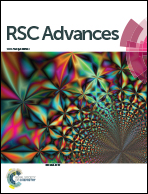Density functional theory (DFT) investigation on the structure and photocatalysis properties of double-perovskite Gd1−xCaxBaCo2O5+δ (0 ≤ x ≤ 0.4)†
Abstract
GdBaCo2O5+δ (GCBC) has been widely used in various applications because of its unique structural characteristics. However, calcium-doped GCBC materials have not been comprehensively studied in terms of their structure and catalytic properties. Based on the first-principles density functional theory, the structure and electronic density of states were revealed by experiments and simulations. Ca-doping has a great influence on the materials' crystal structure, optical absorption, and catalytic performance. Furthermore, Gd0.8Ca0.2BaCo2O5+δ show the best efficiency in the photocatalytic degradation of congo red (C32H22N6Na2O6S2). The presented Ca-doping method affects the overall band structure, electron cloud distribution, and electronic density of states to strengthen the charge-transfer between O-2p and Co-3d orbitals, and Co may be an active site. Our results provide a deep and systematic study on Gd1−xCaxBaCo2O5+δ based on theoretical calculations and experiments, including analysis of crystal structure, electron distribution, and catalytic performance.



 Please wait while we load your content...
Please wait while we load your content...